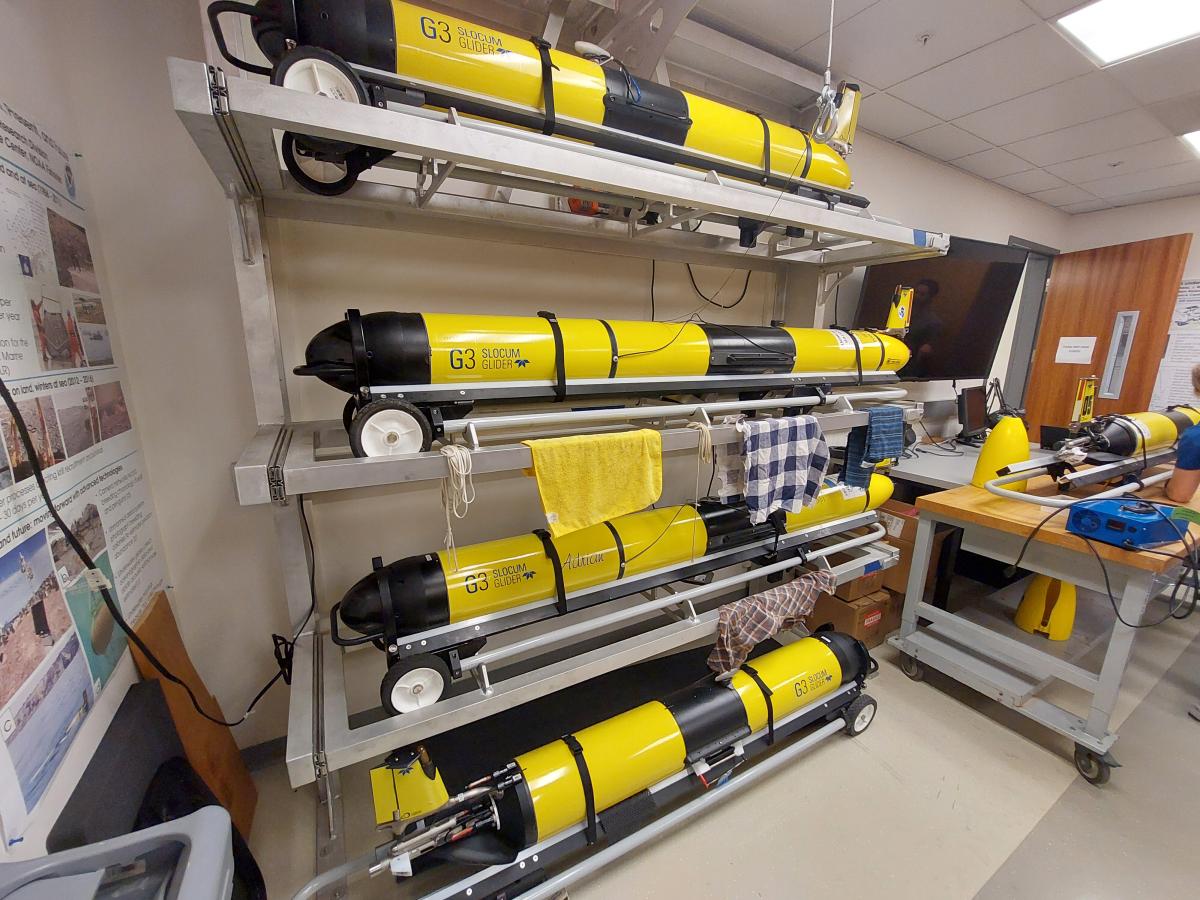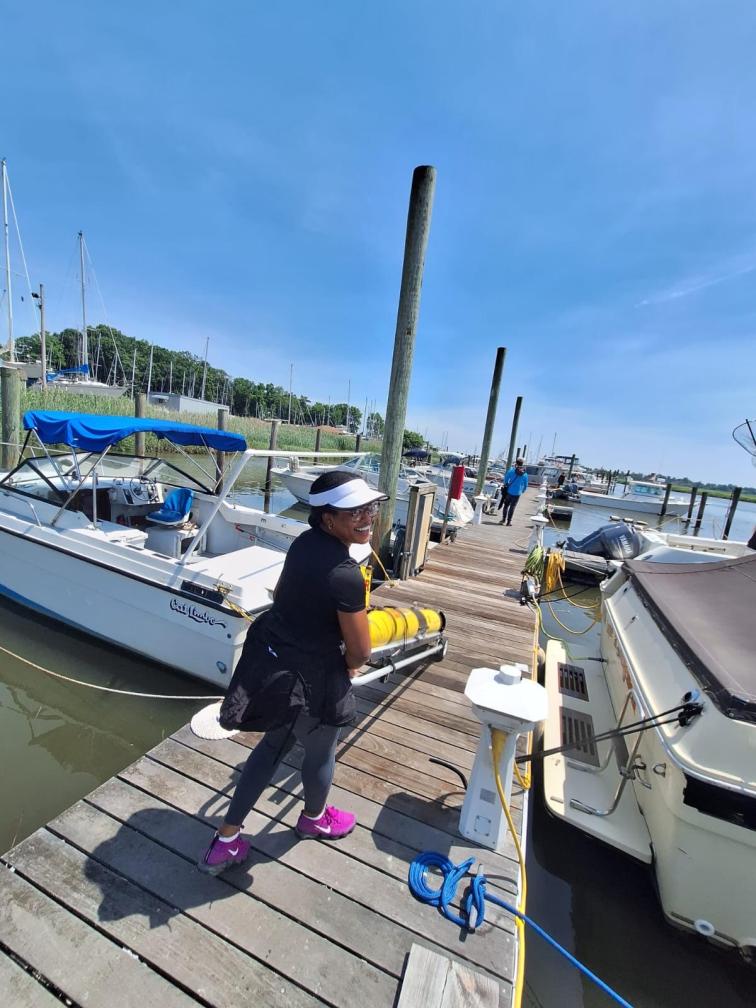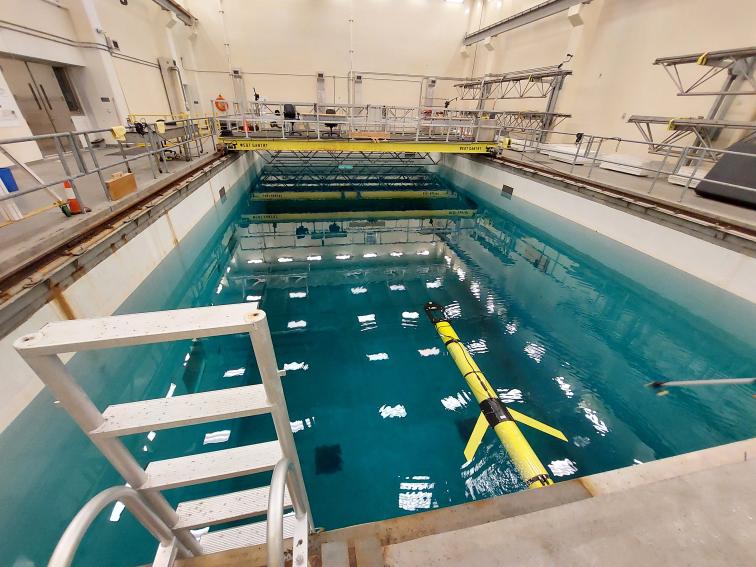
Underwater buoyancy gliders are a type of uncrewed marine system that relies on changes in its buoyancy (through pumps, ballasts, and other means) to move up and down through water. Because gliders lack traditional motors, they don’t use a lot of energy to operate and have a long endurance– meaning they can operate for long periods of time without human contact (sometimes months).
The NOAA Uncrewed Systems Operations Center recently acquired a new Slocum glider (nicknamed ‘Kelpie’) that is the first glider platform in the growing uncrewed systems fleet that the UxS Operations Center is standing up to support data needs across NOAA. ‘Kelpie’ is capable of completing scientific missions to 1000 meter depths and can be outfitted with different scientific equipment. At present, NOAA scientists are exploring the use of gliders in a variety of environments and for a variety of missions. Examples include:
- to inform fisheries management in the Antarctic
- to understand hurricane formation off the U.S Southeast
- to assess changing ocean conditions in the Arctic
- to direct marine mammal population assessments in the Pacific Islands
In order to operate gliders, a trained pilot sends a dive plan to the platform via a satellite iridium phone and online mission control portal, and oversees the glider's operations while it is deployed. This includes checking that the glider is on course, making sure data is being collected, and noting if any system errors occur. Learn more about what it takes to maintain and pilot a glider from one of the Uncrewed Systems Operations Center’s glider pilots, Chesna Cox.

Interview with a Glider Pilot- Pilot Training and Preparing Gliders
Hello! My name is Chesna Cox, I am a Knauss Fellow in the NOAA Uncrewed Systems Operations Center, where I manage the center’s funded projects. My background is in sediment ecology, but I enjoy learning about marine technology and instrumentation. When I got the chance to attend glider pilot training camp with our academic partner, Rutgers University, I was very excited. In the training I learned all about what it takes to maintain and pilot a Teledyne Slocum G2 and G3 glider, and am now part of the Uncrewed Systems Operations Center’s team of glider pilots that support NOAA missions.
Before deploying a glider, it is important to make sure that the glider is prepared to function in the conditions it will be deployed in. This involves a process called ballasting where the glider’s density is adjusted to match the density of the water at the deployment site. Learn more about prepping a glider for deployment by glider experts at the NOAA Southwest Fisheries Science Center.
The buoyancy glider used in the training I attended was a shallow water glider that uses a piston pump to intake or expel water when diving or ascending. Each descent and ascent is known as a “yo.” A dive and ascension together is known as a “yo-yo.” As the glider descends it intakes water to increase the weight of the front of the instrument. To ascend the glider pumps water back out to decrease weight at the front and begins ascending. In addition to this pumping action the glider has other mechanisms to change buoyancy and direction during operations. Learn more about how these gliders move in the water from the NOAA Pacific Marine Environmental Laboratory.
After prepping and ballasting a glider it is ready for deployment. Before launching we make sure to double check that the conditions are the same as predicted, and make any needed adjustments to the glider’s density before deployment by adding weight to the wings on both sides of the glider.

Before operating, we pre-program the glider to know where to go, how deep to dive, and how long to dive. After the glider dives below the surface there is no way to communicate with it. Once at the surface the glider is equipped with a satellite phone to “call in” to the home base to check in and receive further instructions or continue on to the next mission. When setting the path for the glider, we make sure to take precautions when crossing shipping lanes and set waypoints that are well away from known hazards (like permanent structures or icebergs). We can also program the altimeter in the nose of the instrument to change the glider's course at a certain distance from the bottom so the glider doesn’t get stuck. In the event that the glider does get stuck it is equipped with a thruster that can give it an extra boost to get out of a sticky situation.
After acquiring a new corporate uncrewed systems asset like a glider, our team of uncrewed marine system experts at the Uncrewed Systems Operations Center works with the industry vendor to make sure all the parts and components are present and everything is working. Following glider training, I supported the NOAA Uncrewed Marine Systems Division (within the Uncrewed Systems Operations Center) in checking out our newest glider, ‘Kelpie’, to make sure it was in working condition.
This involved opening up ‘Kelpie’ to perform a check of its internal systems. We then performed a test called a “wiggle” which tests the motion of all movable parts on the glider, and made sure ‘Kelpie’s’ satellite phone could call into its mission control portal. Using the mission control portal and satellite phone we are able to pilot the glider remotely anywhere in the world. I’m looking forward to seeing how ‘Kelpie’ can benefit future research projects as a part of NOAA’s growing fleet of uncrewed systems. If you are too, check back in on this page in the future to continue to learn about NOAA’s uncrewed systems work.

